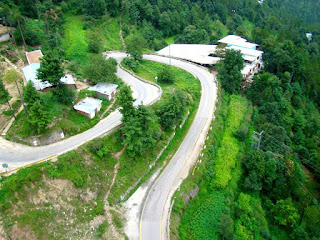Murree (Punjabi, Urdu: مری, "marī", meaning "apex") is an exurb of Islamabad and the administrative centre of Murree Tehsil, in the Punjab province in Pakistan. It is in a subdivision of Rawalpindi District and includes the parts of the Margalla Hills around Islamabad. It is located in the Pir Panjal Range, some 60 km (37 mi) northeast of Islamabad and Rawalpindi via the Murree Road.
Murree was the summer capital of the Punjab Province of British India until 1864. The hill station is a popular getaway destination for Islamabad's populace. It is located on the southern slopes of the Western Himalayan foothills as they ascend northeastwards at an average altitude of 2,291 metres (7,516 ft). It experiences pleasant summers and cold, snowy winters. The city is noted for its Tudorbethan and neo-gothic architecture dating from the colonial era.
History
Murree or Marhee as it was then called, was first identified as a potential hill station by Major James Abbott (Indian Army officer) in 1847.
The town's early development was in 1851 by President of the Punjab Administrative Board, Sir Henry Lawrence. It was originally established as a sanatorium for British troops garrisoned on the Afghan frontier. Officially, the municipality was created in 1850.
The permanent town of Murree was constructed at Sunnybank in 1853. The church was sanctified in May 1857, and the main road, Jinnah Road, originally known as Mall Road and still commonly referred to as "The Mall"), was built. The most significant commercial establishments, the Post Office, general merchants with European goods, tailors and a millinery, were established opposite the church. Until 1947, access to Mall Road was restricted for "natives" (non-Europeans).
In the summer of 1857, a rebellion against the British broke out. The local tribes of Murree and Hazara, including the Dhund Abbasis and others, attacked the depleted British Army garrison in Murree; however, the tribes were ultimately overcome by the British and capitulated. From 1873 to 1875, Murree was the summer headquarters of the Punjab local government; after 1876 the headquarters were moved to Shimla.
The railway connection with Lahore, the capital of the Punjab Province, via Rawalpindi, made Murree a popular resort for Punjab officials, and the villas and other houses erected for the accommodation of English families gave it a European aspect. The houses crowned the summit and sides of an irregular ridge, the neighbouring hills were covered during the summer with encampments of British troops, while the station itself was filled with European visitors from the plains and travellers to Kashmir. It was connected with Rawalpindi by a service of tangas.
It was described in the Gazetteer of Rawalpindi District, 1893–94.
Buildings
Islam is the main religion of Murree, however Christian churches from the British era can still be found in Murree and Nathia Gali. There is an Anglican church, built in 1857, located at the centre of the town, which is still used as a place of worship. Many houses around the church are still standing, functioning mostly as hotels. Old traditional restaurants have been replaced by fast-food shops and newer restaurants.
Tourism
The Murree Galliat region is known for its scenic vistas of pine- and oak-covered mountains, criss-crossed with springs and rivulets and dotted with lawns and orchards. On clear days a good view of the snowy peaks of Kashmir is possible, and the crest of Nanga Parbat can sometimes be seen. Tourist attractions in the area include the Murree Wildlife Park.Whereas Arjun Bhandari, a senior journalist of Nepal, says the place looks like Nagarkot, a tourist destination of Bhaktapur, Nepal.
Patriata (also called New Murree), is one of the pivotal attractions of Murree. This place, which is 15 km away from Murree Hills, is famous for its chairlift that gives a bird-eye view of the Kashmirgreen hills. It is at the highest point of Murree Hills that subsequently makes it the highest point of Punjab as well. Ayubia is also a center of attraction in Murree, which comprises four hill stations including Khanspur, Ghor Daka, Changla Gali, Khairagali. Ayubia Chairlift and shops offering cultural shawls, caps and necklaces are the major appeal of this place. Scenic Nathiagali, situated in Abbottabad at a distance of 2500m from Murree, is popular for its maple, pine, walnut and oak trees. Mall road in Murree is the center of major economic activities. The entire road is full of shops selling a multitude of things for the tourists. Major Banks, hotels and restaurants are situated at Mall Road.
Murree is one of the largest resort towns in the Galyat region of Pakistan, and is the municipal capital of Murree Tehsil, an administrative division of the Rawalpindi District. As well as being tehsil headquarters, Murree is also a Union Council, bounded to the north by Darya Gali and Rawat, to the west by Ghora Gali and Tret, to the south by Numbal and Mussiari, and to the east by Ghel and Angoori.



No comments:
Post a Comment